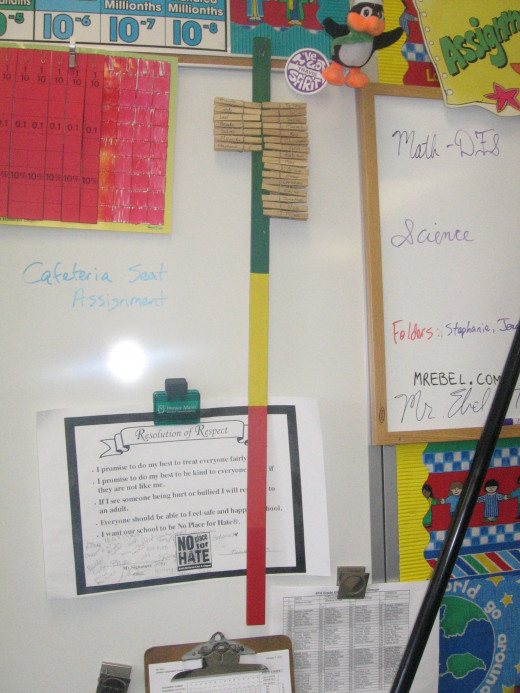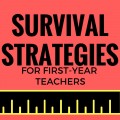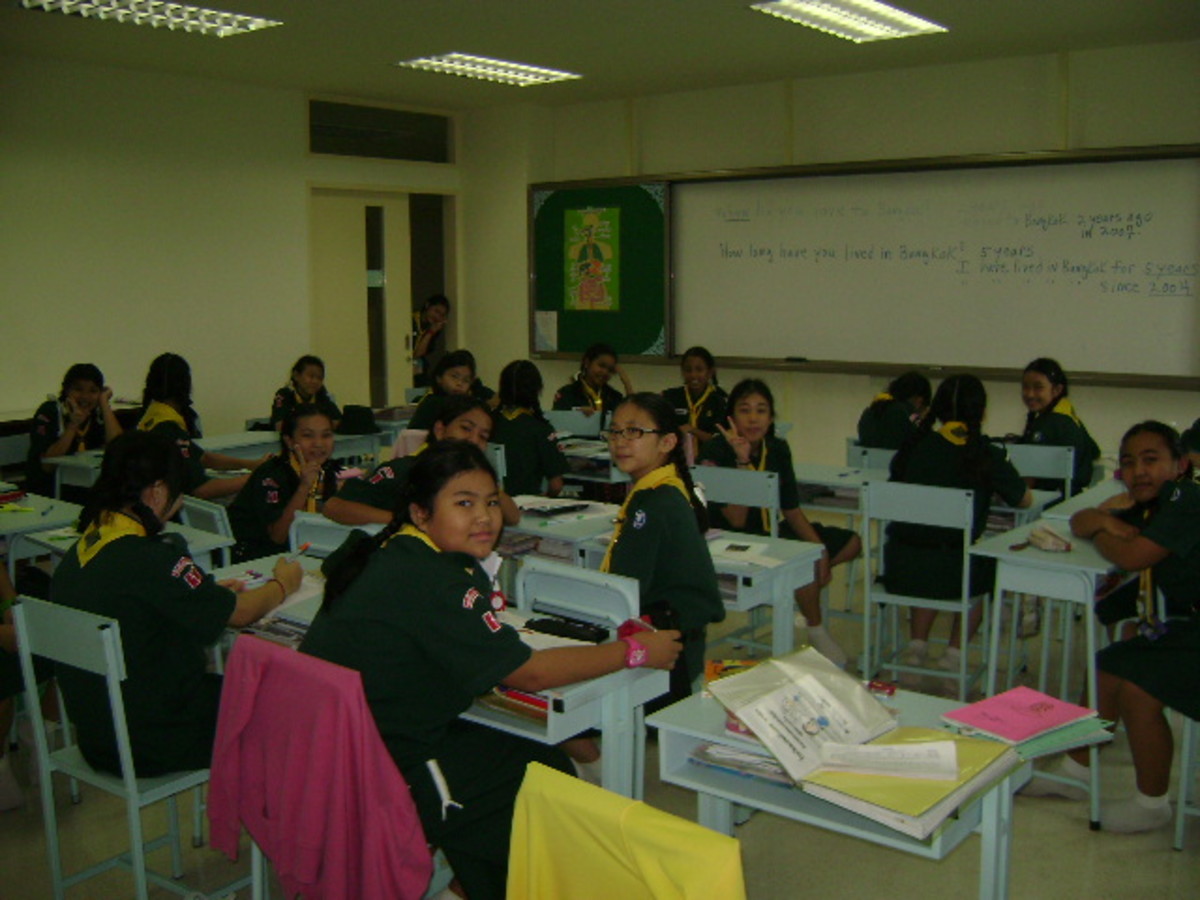Classroom Management Tools

Background and Description: When observing my cooperating teacher during student teaching year, I immediately noticed his classroom management strategy. I observed how detailed and yet proficient it was. He uses it in all areas, from student behavior to them being responsible for turning in work. I was amazed to see how much control the teacher had using his strategy and how this strategy makes students responsible and more likely to remain on task. Basically, the teacher has a color system and a money system that works together in a way. In the front of the class, there is a color-coded yard stick that has clothes pins with student’s names written on them. Green is at the very top where all students start out everyday. Yellow is the second and then there is orange and red (being the worst). Most students do not go beyond yellow. For example, if a student constantly talks, the teacher does not warn them or beg them to stop. He simply goes over to the yard stick and moves them down the color scale. This is not to be cruel but to make the student aware that there are consequences for misbehavior. The students respond quickly to this and stop misbehaving. The teacher also pays them imitation money for (attendance, returning reports, turning in homework timely, and maintaining a green color). There are a few other ways for obtaining money. Students can buy homework passes when the teacher thinks it is appropriate, they can buy extra bathroom breaks, if they loose an exit ticket at the end of the day they can buy another one, they also can buy assignments that they have lost. Most of the time students who are often off task will have to constantly buy these items and gain less money than others.
Design
When I first saw this type of discipline I wondered if it really worked. I also wondered if it was appropriate for 5th graders, and if the students were benefiting from it or were they being oppressed by the rigidness? So I searched for other examples of pretend money being used in the classroom. I found that Rafe Esquith use the same money idea in his book called Teach, "Like Your Hair is on Fire". He also like my cooperating teacher thinks that students should deal with the important aspect of economics. Jobs vary in pay. The teacher in this classroom sees the student’s effort and behavior in his class like a job. There are different efforts, all have the opportunity to make good decisions, but some do not. It is only fair that those who work the hardest get paid the most. That is his philosophy, which I could some what compare to Mr. Esquith’s.
Patterns
I noticed how students take pride in achieving the teacher’s praise and when they are paid the imitation money, I see a look of satisfaction on their faces. It is like a piece of the real world in an every day classroom. I could say I was totally surprised that the system does not have any broken parts. The cooperating teacher sticks to what he says. The rules never waiver, everything is consistent. Students know that there are no loop holes. Also I observed how organized the teacher’s records and daily information is gathered and how easy it is to assess when needed. Everything is documented on one of his clipboard checklists or on his board. Watching my cooperative teacher’s approach to discipline has taught me that why students need praise, encouragement and love. They need to learn the skill of accountability. If students are taught to be accountable then we as teachers are fostering intrinsic motivation. I was happy to see that the imitation money was not for the purchase of gifts or goody bags. These kids are paying for their actions good or bad. That is what real life is all about. I think this teacher is doing these students a favor by teaching them early on what decisions cost, and or pay. Also the teacher is not stressing constantly, for example, about recreating missing documents for irresponsible students or students constantly escaping class for needless bathroom trips. The system works and the students respect it. When someone is for example grading their work and the person beside them is filling in the answers as the teacher calls them out. The student who did all the work is anxious to expose the fraud next to them. The teacher even checks for honesty by pulling names to randomly check to see who is honest. Since I have been watching this class I have never seen anyone lie. They are up front when they do not do their assignments. I was so amazed how well the system works across the board. The only data I am missing is the scientific proof or the psychiatrist approval of this. In other words, I wonder about professionals who know what is developmentally appropriate for children, would they agree that this strategy is gold. Would some say that this system expects too much from the child? I am not sure. I think with more research I could find these answers or maybe it is just the matter of opinion.
Conclusion:
My teaching will forever be impacted by what I saw in a 5th grade classroom during my student teaching. Watching the way this well, experienced teacher had confidence and did not waiver from his strategy, taught me how to begin to think about creating my own discipline strategy. I do not feel afraid to be faced with classroom management. In this rotation I had opportunities to practice strategies that worked marvelously for me. I am not sure if I will fully implement all of the teachers strategies, but I know I will take a lot of what I have seen. I think that I could use for example,imitation money for students at the appropriate age, to teach them about the ends and outs of responsibility and the rewards for good work. I could probably use this concept with younger students also. I would not expect as much from say, Kindergarten or First grade, however, the concept could be implemented in a smaller way.
As I have taught in my own classroom I have learned that their is not a one strategy that works for all, teachers are as different as their students, just as they learn differently from each other we as teachers all have our own unique teaching style and we relate differently, so classroom management tools should be tailored to the students' needs and should also fit the teacher's philosophy.
- 5E lesson plans examples
Grades 3-5 Materials: pencils colors(optional) construction paper video clip TV/DVD Player Objective: Students will learn how to analyze important characters in a story by looking at their personalities and the conflicts that... - What are the roles of an effective teacher?
1.Facilitator:The teacher's purpose is to welcome learners to learn. The best teachers make learning very inviting. Would you want to learn in an uninviting classroom? Facilitating means to open up your class with a learning environment that is safe. - Differentiation in the Classroom
Differentiation is the idea of varying a technique or task to recognize differences. For so long people have always seemed to think that there is one way to do things right. However, considering that we are all different individuals, coming from... - Beginner Teacher: Step by step procedure for turning...
Kronowitz says: - Activities for 6-9 year olds
Our first, second,third and fourth graders are growing so fast. They use to be our babies, now they are learning to read and do arithmetic. I am anxious to share developmental knowledge and appropriate activities for these middle age kids. I would... - How to create a 5 E Lesson Plan
The 5 E lesson plan format is described and explained.









